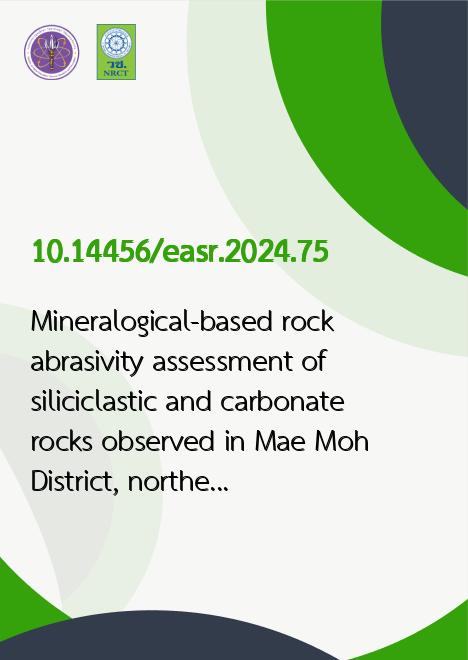
|
Mineralogical-based rock abrasivity assessment of siliciclastic and carbonate rocks observed in Mae Moh District, northern Thailand |
|---|---|
| รหัสดีโอไอ | |
| Creator | 1. Nat Setteetorn 2. Tadsuda Taksavasu |
| Title | Mineralogical-based rock abrasivity assessment of siliciclastic and carbonate rocks observed in Mae Moh District, northern Thailand |
| Publisher | Faculty of Engineering, Khon Kaen University |
| Publication Year | 2567 |
| Journal Title | Engineering and Applied Science Research |
| Journal Vol. | 51 |
| Journal No. | 6 |
| Page no. | 800-809 |
| Keyword | Equivalent quartz content, Petrography, Rock abrasivity index, Rosiwal hardness, Tool wear prediction |
| URL Website | https://ph01.tci-thaijo.org/index.php/easr/index |
| Website title | Engineering and Applied Science Research |
| ISSN | 2539-6161 |
| Abstract | Understanding a target rock's characteristics and tool wear behaviors after cutting that rock significantly leads to appropriate tool selections and reliable tool lifetime prediction for ground excavation or drilling activities in mining and construction industries. Rock abrasivity is defined as the ability of rocks to cause damage to cutting tools. There are several methods for investigating the abrasivity of rocks ranging from micro-scale geotechnical approaches to real-scale in-situ tests. Applying mineralogical analysis to the rock abrasivity assessment methods for the tool wear prediction is lacking in detail, despite its simplicity, effectiveness, and affordability. This study preliminarily tests the abrasivity of four stratigraphic sedimentary units hosted in the Mae Moh Basin, northern Thailand, by investigating a rock abrasivity index (RAI). The method involves microscopic petrographic analysis, equivalent quartz content (EQC) determination, and the uniaxial compressive strength (UCS) tests. The RAI of each representative rock unit is a product of its EQC and UCS. The petrographic results reveal that the rock samples are sandstones and limestones. The sandstones can be divided into two subtypes including sublithic and lithic arenites with the EQC of 90.3% and 43.3%, respectively. The limestones, on the other hand, show the opposite values of below 3%. The UCS results suggest that the strengths of sandstones are higher than limestones. Additionally, the lithic-rich sandstone shows the highest UCS value (92.2 MPa). The calculated RAI of sandstones ranges from 39.9 to 72.5, indicating medium-to-very abrasive materials, whereas the limestones show RAI values of less than 2, indicating non-abrasive rocks. Determination of rock abrasivity using its mechanical and mineralogical properties appears to be a practical method for drilling or excavation strategies. |